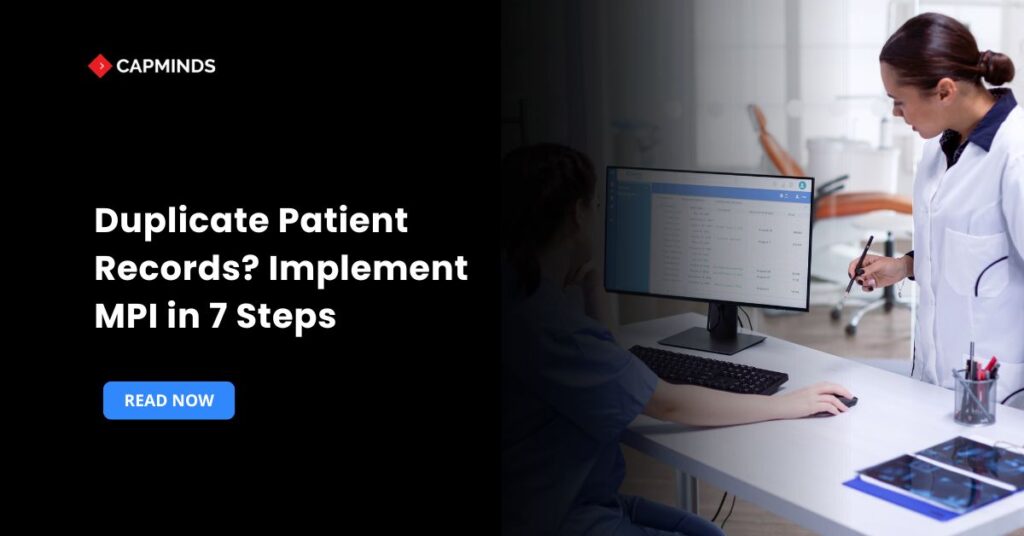Duplicate Patient Records? Implement MPI in 7 Steps
Duplicate patient records occur more frequently than many organizations admit. Market research and industry surveys indicate that duplicate rates across enterprises typically range from 10% to 18%. These duplications affect clinical history, lead to billing problems, and confuse care teams, all of which destroy trust in your data.
Analysts estimate that patient identity errors and duplicate/mismatched records cause thousands of preventable adverse events each year, resulting in billions of dollars in liability and rework costs for the healthcare system.
In this blog, you’ll know how duplicate patient records affect healthcare organizations and the 7 steps to implement a master patient index.
What is a Master Patient Index?
A Master Patient Index, also known as an Enterprise Master Patient Index (EMPI) when used across multiple sites, is a central service that identifies, links, and manages unique patient identities across various systems.
An MPI holds fundamental demographic keys and corresponding regulations. In this method, a single individual can be seen only in a single location throughout the enterprise, allowing clinicians to locate the proper document in the shortest amount of time possible. This minimizes duplicate creation and enhances record accuracy.
The adoption of EMPI services by the organizations offers a repeatable identity layer, which promotes safer care, cleaner claims, and more trustworthy reporting.
7 Steps to Implement an MPI
There are seven actual steps that you can use to design, deploy, and operationalize an MPI, as presented below. Every step describes a procedure, a reason why it is important, and actual tasks that you can assign to teams.
1. Evaluate the Current State
Start by calculating the size and the cost of duplicate records within systems. In practice, it consists of carrying out a duplicate-detection audit and approximating the operational and safety impacts.
Why is it important:
You cannot have a solution as a priority until you are knowledgeable about where duplicates are present, such as registration, labs, and external HIEs. Typical outputs:
- Baseline duplicate rate per system (EHR, lab, radiology).
- Cost per duplicate (rework, claims denied, calling the patient back).
- Incidents or close calls associated with inappropriate identities.
Many businesses discover median duplicate rates of roughly 10%, with averages higher in fragmented ecosystems; use this baseline to set reasonable goals.
2. Develop Governance, naming conventions, and data standards
Form a cross-functional data governance team, such as IT, HIM, registration, clinical leads, and compliance. Then establish compulsory demographic fields and name conventions and authoritative sources such as driver’s license, national ID, and validated phone.
Why it matters:
Differences in data entry are one of the leading reasons for duplicates. Governance guarantees continuous improvements and implements the regulations according to which the MPI relies.
Core Governance Deliverables
- Demographic elements and format rules are necessary.
- Alias name policy, cultural naming order policy, and missing data policy.
- Merge/Overlay decision-making escalation processes.
3. Select the appropriate MPI/EMPI technology
Evaluate your options like commercial EMPIs, cloud identity services, or open-source solutions. Key selection criteria:
- Support for deterministic and probabilistic matching.
- FHIR and HL7 interfaces for interoperability.
- Scalability and performance SLAs
- Data cleansing and deduplication capabilities
- Tools for manual review and merging with the audit trail.
Why it matters:
Technology selection influences match accuracy, integration effort, and operational overhead. A modern EMPI with adjustable match criteria and FHIR-ready APIs will reduce integration friction and ensure future-proof identification procedures.
Vendor checklist example:
- Match algorithms support probabilistic, deterministic, phonetic, and address normalization.
- API support (FHIR Patient, v2 ADT, and bulk-match endpoints)
- Reporting and KPI dashboards
4. Clean Data: Run Early Data Matching Projects
Conduct extensive data cleaning, clean up of formats, standardization of addresses, correction of frequent errors in data entry, and elimination of blatant duplicates, until the data is fully deployed.
Why is it important:
There is a reality of garbage in – garbage out: pre-cleaning will reduce false positives/negatives, and will make match rules more effective. It is common in many orgs to run dedupe jobs in iterations, review results, and be more and more automated with more confidence.
AHIMA
Operational Checklist:
- Standardize name arrays such as prefixes, suffixes, addresses, and telephone formats.
- Run deterministic passes (exact SSN, exact DOB + name) followed by probabilistic passes.
- Enhance clear SLA by creating manual review queues of the uncertain matches.
Related: Custom Software That Reduces Admin Time and Maximizes Patient Impact
5. Combine MPI with Clinical and Administrative
The second step is to integrate the MPI into registration systems, EHRs, lab systems, HIEs, and revenue-cycle systems through common interfaces (FHIR, HL7 v2/v3). Make sure front desk processes make real-time calls to the MPI when registering/admitting.
Why is it important:
Integration will remove duplicates downstream by making sure that a system consults the MPI before adding a new patient to its system. In addition, it allows guided human review and real-time alerting, like possible duplicate finds.
Integration tasks:
- Use real-time API calls in ADT processes.
- Include front-end prompts for registration clerks on potential matches that come back on the MPI.
- Log all merges/overlays with the user ID and reason for auditability.
6. Automate Identification and Employee Training
Implement front-desk identity-proofing (request two IDs and scan ID when permitted) and educate workers on MPI processes such as how to validate potential matches, when to combine, and when to create a new record.
Why is it important:
Sometimes people are the ones to decide whether or not to duplicate something, although technology will help prevent them. By having trained staff, you can reduce the possibility of wrong merges and maintain the MPI over time.
Process and tech surveys have been conducted in the industry and have been proven to give the best results.
Training & workflow tips:
- Develop short-term job aids for front desk staff.
- Create a check before making a rule in the patient registration screen.
- Carry out periodic spot audits and refresher training.
7. Measuring KPIs, optimizing match rules
Keep track of current performance: duplicate rate, number of mergers per month, manual review backlog, and automatic match %. Continuously improve these KPIs to lower thresholds.
Why is it important:
With no measurement, the rates of duplicates return slowly. The constant monitoring assists you with the identification of new sources of problems when a new clinic with new data formats and experimentation with match logic. Target specific improvements and report to the stakeholders.
Suggested KPIs:
- Duplicate records per month.
- Manual reviews and the mean time of review.
- Automatic approval percentages for merges as compared to manual.
- Patient Safety Incidents related to patient identities.
Transform Patient Data With CapMinds Services
Duplicate patient records don’t just create inefficiencies; they put patient safety and compliance at risk. At
CapMinds, our digital health tech services, are designed to help healthcare organizations eliminate data silos, unify patient identities, and improve accuracy across every workflow.
Our service expertise includes:
- Custom EHR/EMR Development – Tailored solutions with seamless integration and automation to prevent duplicate entries.
- Patient Portal Services – Empower patients with secure access to health data while ensuring accuracy and compliance.
- Patient Data Management – Robust MPI/EMPI services that standardize, cleanse, and unify records across systems.
- Interoperability & Integration – HL7, FHIR, and API-based integrations to create a unified patient record.
With CapMinds, you get more than technology; you gain a partner who helps reduce errors, protect revenue, and build patient trust with accurate, reliable data.
Let’s build a healthcare system where data works for you, not against you. Book a free consultation today.




